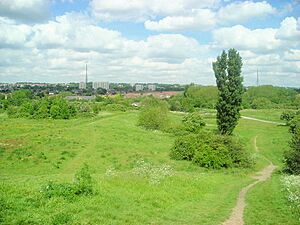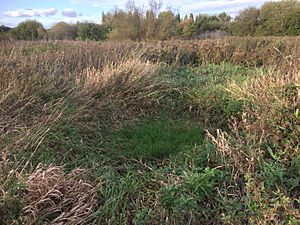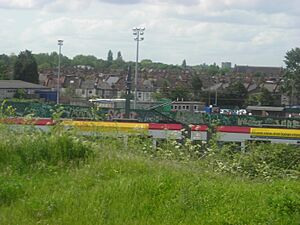South Norwood Country Park facts for kids
South Norwood Country Park is a large, green park in South Norwood, London. It's easy to reach, located near the Elmers End and Birkbeck train stations. This park covers about 47 hectares (116 acres) and first opened in 1989.
The park is a mix of open countryside and parkland. It was once used for sewage farms, which helped treat waste from London. Today, it's a lovely place for nature and outdoor activities. The Croydon Sports Arena, where Croydon F.C. plays, is right next to the park. You'll also find a car park, a visitor centre, and a duck pond here.
Contents
The Park's Past: A Journey Through Time
The land that is now South Norwood Country Park has a very interesting history. It has changed many times over the years. It was once part of a huge forest called the Great North Wood. Later, it became home to an old moated house. It was also a sewage farm, farmland, and even a place used during the war. Now, it's a beautiful country park for everyone to enjoy.
La Motes: A Medieval Moated Site
Long ago, a medieval manor house stood here, surrounded by a moat. This old site is now a protected historical area. In 1972, experts dug up parts of the land to learn more about this moat. Old maps from the 1700s called the site "La Motes."
Records from the 1400s mention land called "Leweland" in this area. Even older documents suggest a manor house was here in the 1200s or 1300s. A very important judge named Robert de Retford owned the land back then. It's thought that big floods, like those in the early 1300s, might have caused the house to disappear.
Most of the old moats were filled in when the land became a sewage farm. The site had two moats, one inside the other. In the middle was a square area where the manor house once stood. Today, this spot is covered with plants, but you can still see hints of it in old photos from above.
From Sewage Farm to Green Space
Around 1862, the local council bought this land to use as a sewage farm. This was a way to treat London's waste. However, it didn't work very well because the ground was mostly heavy London Clay. This clay made it hard for water to drain away. Concrete channels were built to move the sewage, but the areas where it collected often stayed flooded for months.
By the 1920s, a new way to treat sewage was needed. So, the old farm was mostly closed down. A new sewage treatment plant was built nearby, where the park's pitch and putt course is now. This new plant closed in 1962. After that, the land was left mostly untouched until the Country Park was created in 1988-1989. Older local people still sometimes call it 'the Sewage Farm,' even though it hasn't been used for that in many years.
The Park During Wartime
The years leading up to World War II brought big changes to the area. The armed forces used the land for training exercises. During the war, it became an Air Raid Precaution (A.R.P.) centre. This is where people prepared for air raids and helped after bombs fell. A civil defence unit also stayed here until the 1950s. There was even a ruined house built just for rescue teams to practice in.
During the Blitz, when many buildings in Croydon were bombed, a lot of the broken pieces were dumped on this land. This rubble piled up over time to form the large hill you see behind the sports arena today. This hill is the best spot in the park for views. From the top, you can see places like the London Docklands, Shirley Hills, Crystal Palace, and Bromley.
The park is also the end point of a cycling path from Greenwich. This path is called the Waterlink Way.
Fun at the Playground
The playground at South Norwood Country Park was closed for a while in 2006 for safety reasons. But don't worry, it has been rebuilt!
In 2008, Croydon Council built a new playground. It was funded by the lottery. This playground is in a large area that used to be part of the pitch and putt course. The equipment is designed for children aged 4 to 14 years old.
Amazing Wildlife and Nature
South Norwood Country Park is a fantastic place for wildlife. It has many different types of habitats, which means it's home to a wide variety of plants and animals. It's also an important place for nature protection. Because of this, it is known as a Local Nature Reserve.
Many ponds and wetlands in Britain have become polluted or have disappeared. This means plants and animals that need wet places to live have fewer homes. The park built the Dragonfly Pond to help dragonflies and damselflies. You can also find frogs, toads, and newts living there. In the summer, you might even spot the large blue and green Emperor Dragonfly, which is the biggest dragonfly in Britain!
South Norwood Country Park is also a great place for birdwatching. More than 100 different types of birds are seen here every year. The large wetland areas are especially popular with many different kinds of birds.




